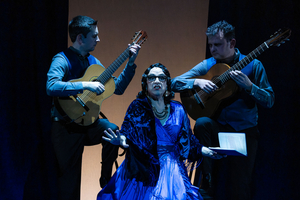 Reviewed by Barry Lenny, Wednesday 14th July 2021.
Reviewed by Barry Lenny, Wednesday 14th July 2021.
Brink Productions, as part of the State Theatre Company of South Australia's Stateside season, is presenting
The Bridge of San Luis Rey, adapted by Phillip Kavanagh from Thornton Wilder's 1927 Pulitzer Prize-winning second novel, as part of this year's Adelaide International Guitar Festival. Directed by Chris Drummond, it features the multi-talented performer, Paul Capsis, and guitarists, Slava Grigoryan, Artistic Director of the Festival, and Manus Noble. Musical direction is by Slava Grigoryan, and his brother, Leonard.
The story is told, in this adaptation, through the characters who died, and the Abbess who saw it, all played by Capsis. Five people died on July 20th, 1714, when a rope bridge, woven by the Inca a century before, collapsed as they were crossing. The novel had Brother Juniper, a Franciscan friar who was about to cross the bridge and witnessed the accident, tell the story through the filter of his religious beliefs, but he is dropped from this reinterpretation. This work links the five, telling their individual and collective stories, bringing them together at the bridge.
Those who died were the actress, Camila Perichole, the Marquesa de Montemayor, a drunk who writes letters to her daughter, Doña Clara, who married and went to Spain to avoid her, Pepita, an orphan who had been directed by the Abbess Madre María del Maria to be the Marquesa's companion, Esteban, saddened and feeling guilty about the death of his twin brother, Manuel, and Uncle Pio, who discovered Camila and made her a star, and who is taking her son, seven-year-old Jaime to educate him.
Capsis creates all of these characters with a couple of costume, wig, or hairstyle changes but, more so, with impressive variations in his voice, delivery, and demeanour, even engaging in conversations between characters, instantly switching to and fro between them. He is also La Perichole as the narrator, linking the stories. It is a ninety-minute, non-stop tour-de-force.
It all takes place on Jonathon Oxlade's bare, circular, wooden stage, initially set with two chairs, and with curtains at the rear. They open revealing the performers, and Capsis, as the elaborately dressed La Perichole, sings
No Puede Ser, by Pablo Sorozabal, Federico Romero, and Guillermo Fernandez Shaw, in Spanish, reads the opening lines of the book, finishes the song, and speaks of the letters written by the Marquesa to her daughter, also describing the Marquesa's unfortunate physical appearance. The costumes are also designed by Jonathon Oxlade. We begin to see what will reveal itself as an intricate and atmospheric lighting plot, designed by Gavin Norris, which adds so much to the production.
The Marquesa goes to the Commedia with Pepita, and talks loudly about the performance, while the embarrassed and angry Pepita tries to silence her. La Perichole sings an improvised song, berating the Marquesa for her chattering, and makes fun of her looks and her failed relationship with her daughter. The couple behind me chattered during it. Irony! My blistering, black stare silenced them.
When Perichole visits the Marquesa to apologise we suddenly hear the latter say, "there is, like, no way", that awful, modern destruction of the English language jarring horribly against the words that were taken directly from the novel. Why, oh why, was that felt appropriate? It was not the only time that the script descended into the vernacular. There is also the matter of the very distracting notebook, from which Perichole reads periodically, which gives the unfortunate, unintended impression that Capsis is working 'script in hand'.
Capsis is a remarkable performer whom we have had the opportunity to see in numerous roles in Adelaide, nobody could forget Little Bird, and his performance in a range of roles in this production is exceptional. Aside from playing a collection of distinctly different characters, each instantly identifiable in his interpretations of them, there is also the emotional range required for each of them that he navigates with great skill.
On stage with Capsis are the two superb musicians. I have had the pleasure of hearing Slava Grigoryan many times, and I would probably even risk an Incan rope bridge to hear him play. I had not heard Manus Noble until the Classical Celebration concert. He's worth crossing a ravine to hear, too. Together, they provided a sensational evening of largely Latin American-influenced music.
The music does not confine itself to either the beginning of the 18th Century, the time of the story, or the beginning of the 20th Century, when it was written, nor, for that matter, to Peru. I doubt that it would have worked as well with siku (pan-flute), charango, tinya (small drum), and huancar and bombo (large drums). The guitars have a far more expressive range and can achieve great subtlety, as well as power and excitement. The music, in fact, is wide-ranging and eclectic, chosen to fit the narrative.
The composers, Agustín Barrios and Astor Piazzola, came as no surprise, and Manuel de Falla and Isaac Albeniz fitted in nicely. William Byrd, and Bach, sat alongside original works. Slava, Leonard, and Edward Grigoryan all had a hand in either writing or arranging. It even included Sia's Chandelier, albeit in an interesting arrangement, a distinct improvement on the original.
You have until 24th July to catch this fascinating production but, with COVID-19 affecting capacities, book soon or you might miss out.
Photography, Chris Herzfeld.
Reader Reviews
To post a comment, you must
register and
login.
 Reviewed by Barry Lenny, Wednesday 14th July 2021.
Reviewed by Barry Lenny, Wednesday 14th July 2021.
